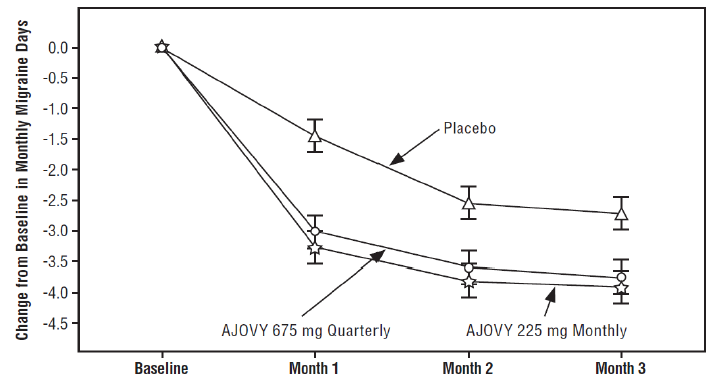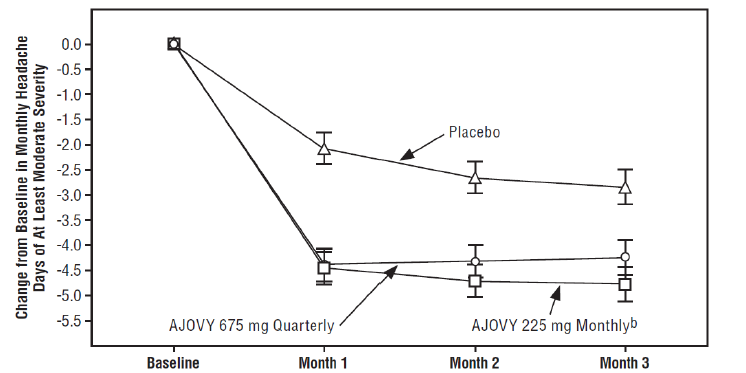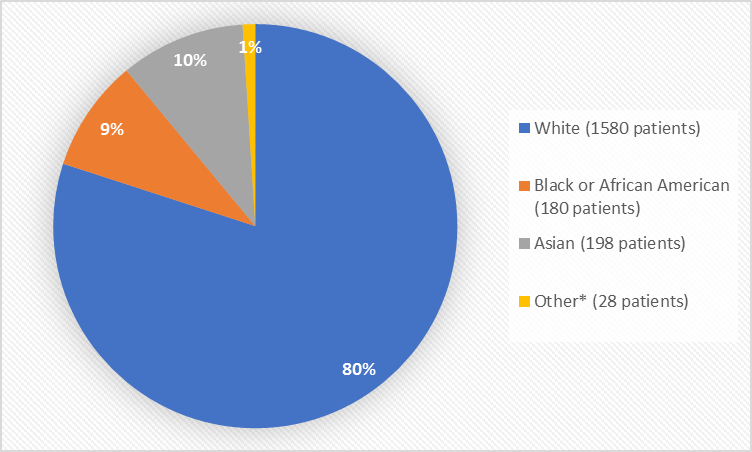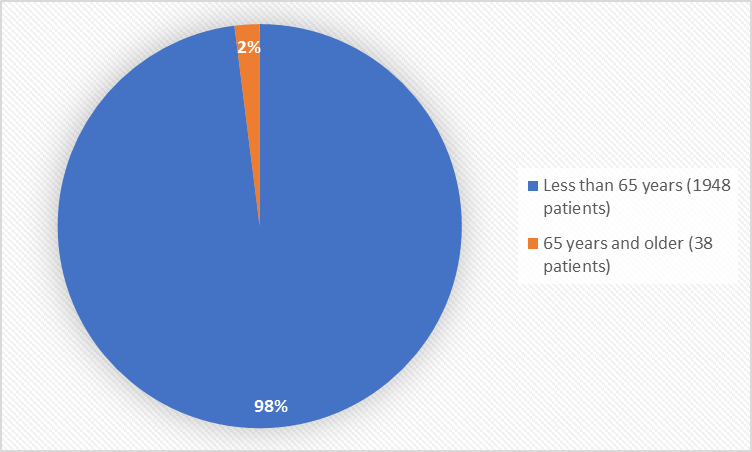Drug Trials Snapshot: AJOVY
HOW TO USE THIS SNAPSHOT
The information provided in Snapshots highlights who participated in the clinical trials that supported the FDA approval of this drug, and whether there were differences among sex, race and age groups. The “MORE INFO” bar shows more detailed, technical content for each section. The Snapshot is intended as one tool for consumers to use when discussing the risks and benefits of the drugs.
LIMITATIONS OF THIS SNAPSHOT:
Do not rely on Snapshots to make decisions regarding medical care. Always speak to your health provider about the risks and benefits of a drug. Refer to the AJOVY Package Insert for complete information.
AJOVY (fremanezumab-vfrm)
Ah-JOE-vee
Teva Pharmaceuticals USA, Inc.
Approval date: September 14, 2018
DRUG TRIALS SNAPSHOT SUMMARY:
What is the drug for?
AJOVY is a drug used for the preventive treatment of migraine in adults.
A migraine is a type of headache that can be associated with nausea, vomiting, and sensitivity to light, sound, or smell.
How is this drug used?
AJOVY is an injection given under the skin (subcutaneous). Two dosing options are available for AJOVY (one subcutaneous injection once a month or three subcutaneous injections once every three months).
What are the benefits of this drug?
Over the three-month treatment period, patients treated with AJOVY experienced fewer days of migraine headaches in comparison to patients who received placebo treatment.
What are the benefits of this drug (results of trials used to assess efficacy)?
The figures below summarize efficacy results for the evaluated patients in Trials 1 and 2. The primary outcome was the change in monthly migraine days (MMD) for Trial 1 and the change in monthly headache days of at least moderate severity for Trial 2.
Figure 4. Change from Baseline in Monthly Migraine Daysa: Trial 1
a LS (least-square) means and standard error of the mean are presented.
AJOVY Prescribing Information
Figure 5. Change from Baseline in Monthly Headache Daysa of At Least Moderate Severity in Trial 2
a LS (least-square) means and standard error of the mean are presented.
b In Trial 2, patients received a 675 mg starting dose.
AJOVY Prescribing Information
Were there any differences in how well the drug worked in clinical trials among sex, race and age?
- Sex: AJOVY works similarly in both men and women.
- Race: The majority of patients were White. The number of patients in other races were limited; therefore, differences in how AJOVY worked among races could not be determined.
- Age: The majority of patients were less than 65 years of age; therefore, differences in how AJOVY worked among age groups could not be determined.
Were there any differences in how well the drug worked in clinical trials among sex, race, and age groups?
The tables below summarize Trial results by sex, race and age. Racial subgroup differences were investigated between White race and all other races combined because the majority of patients was White.
Table 2. Trial 1 Episodic Migraine Subgroup Analysis
| Change in Monthly Average Number of Migraine Days | AJOVY 225 mg Monthly |
AJOVY 675 mg Quarterly |
Placebo |
|---|---|---|---|
| Sex | |||
| Men | |||
| N (%) | 45 (15.7) | 39 (13.5) | 46 (15.9) |
| LS mean (SE) | -3.9 (0.59) | -3.6 (0.66) | -2.8 (0.58) |
| LS mean (SE) vs. Placebo | -1.1 (0.74) | -0.9 (0.77) | |
| Women | |||
| N (%) | 242 (84.3) | 249 (86.5) | 244 (84.1) |
| LS mean (SE) | -3.5 (0.24) | -3.3 (0.24) | -2.0 (0.24) |
| LS mean (SE) vs. Placebo | -1.5 (0.30) | -1.3 (0.29) | |
| Race | |||
| White | |||
| N (%) | 240 (83.6) | 231 (80.2) | 222 (76.6) |
| LS mean (SE) | -3.7 (0.28) | -3.5 (0.29) | -2.2 (0.28) |
| LS mean (SE) vs. Placebo | -1.5 (0.30) | -1.3 (0.30) | |
| Other | |||
| N (%) | 47 (16.4) | 57 (19.8) | 68 (23.4) |
| LS mean (SE) | -3.6 (0.61) | -3.5 (0.58) | -2.3 (0.56) |
| LS mean (SE) vs. Placebo | -1.3 (0.71) | -1.2 (0.67) | |
| Age Group | |||
| <25 years | |||
| N (%) | 25 (8.7) | 24 (8.3) | 27 (9.3) |
| LS mean (SE) | -3.4 (1.03) | -4.7 (1.03) | -3.6 (0.91) |
| LS mean (SE) vs. Placebo | 0.2 (1.06) | -1.1 (1.07) | |
| 25 to <45 years | |||
| N (%) | 129 (45.0) | 143 (49.7) | 138 (47.6) |
| LS mean (SE) | -3.4 (0.39) | -3.2 (0.39) | -1.9 (0.40) |
| LS mean (SE) vs. Placebo | -1.5 (0.40) | -1.3 (0.39) | |
| > 45 years | |||
| N (%) | 133 (46.3) | 121 (42.0) | 125 (43.1) |
| LS mean (SE | -3.9 (0.34) | -3.4 (0.36) | -2.1 (0.35) |
| LS mean (SE) vs. Placebo | -1.8 (0.40) | -1.4 (0.41) | |
FDA Review
Table 3. Trial 2 Chronic Migraine Subgroup Analysis
| Change in Monthly Average Number of Migraine Days | AJOVY 225 mg Monthly* |
AJOVY 675 mg Quarterly |
Placebo |
|---|---|---|---|
| Sex | |||
| Men | |||
| N (%) | 48 (12.8) | 45 (12.0) | 45 (12.1) |
| LS mean (SE) | -4.4 (0.71) | -3.0 (0.75) | -2.8 (0.75) |
| LS mean (SE) vs. Placebo | -1.6 (0.92) | -0.3 (0.93) | |
| Women | |||
| N (%) | 327 (87.2) | 330 (88.0) | 326 (87.9) |
| LS mean (SE) | -4.8 (0.28) | -4.6 (0.28) | -2.6 (0.28) |
| LS mean (SE) vs. Placebo | -2.2 (0.36) | -2.0 (0.36) | |
| Race | |||
| White | |||
| N (%) | 294 (78.4) | 292 (78.4) | 301 (81.1) |
| LS mean (SE) | -4.7 ((0.36) | -4.2 (0.36) | -2.5 (0.36) |
| LS mean (SE) vs. Placebo | -2.2 (0.36) | -1.8 (0.38) | |
| Other | |||
| N (%) | 81 (21.6) | 83 (22.1) | 70 (18.9) |
| LS mean (SE) | -4.2 (0.60) | -4.5 (0.61) | -2.7 (0.65) |
| LS mean (SE) vs. Placebo | -1.5 (0.75) | -1.8 (0.74) | |
| Age Group | |||
| <25 years | |||
| N (%) | 34 (9.1) | 32 (8.5) | 31 (8.4) |
| LS mean (SE) | -3.9 (1.08) | -4.1 (1.13) | -2.9 (0.99) |
| LS mean (SE) vs. Placebo | -1.0 (1.03) | -1.2 (0.50) | |
| 25 to <45 years | |||
| N (%) | 197 (52.5) | 173 (46.1) | 183 (49.3) |
| LS mean (SE) | -4.7 (0.45) | -3.8 (0.45) | -2.5 (0.47) |
| LS mean (SE) vs. Placebo | -2.1 (0.50) | -1.2 (0.50) | |
| > 45 years | |||
| N (%) | 144 (38.4) | 170 (45.3) | 157 (42.3) |
| LS mean (SE) | -4.7 (0.46) | -4.8 (0.46) | -2.3 (0.46) |
| LS mean (SE) vs. Placebo | -2.4 (0.53) | -2.5 (0.51) | |
*Patients received a 675 mg starting dose.
FDA Review
What are the possible side effects?
AJOVY may cause serious hypersensitivity reactions including rash, itching and hives.
The most common side effect of AJOVY was injection site reactions.
What are the possible side effects (results of trials used to assess safety)?
The table below summarizes adverse reactions in adult patients with chronic or episodic migraine headaches in combined trials (safety population).
Table 4. Adverse Reactions Occurring with an Incidence of At Least 2% for Either Dosing Regimen of AJOVY and At Least 2% Greater Than Placebo in Trials 1 and 2
| Adverse Reaction | AJOVY 225 mg Monthly (n=290) % |
AJOVY 675 mg Quarterly (n=667) % |
Placebo Monthly (n=668) % |
|---|---|---|---|
| Injection Site Reactionsa | 43 | 45 | 38 |
aInjection site reactions include multiple adverse reactions related terms, such as injection site pain, induration, and erythema.
AJOVY Prescribing Information
Were there any differences in side effects among sex, race and age?
- Sex: The occurrence of side effects was similar in men and women.
- Race: The majority of patients were White. The number of patients in other races was limited; therefore, differences in side effects among races could not be determined.
- Age: The majority of patients were less than 65 years of age; therefore, differences in side effects among age groups could not be determined.
Were there any differences in side effects of the clinical trials among sex, race, and age groups?
The table below summarizes the occurrence of the most common adverse reaction, injection site reactions, by subgroup.
Table 5. Subgroup Analysis of Injection Site Reactionsa (safety population)
| Demographic Characteristic | AJOVY 225 mg Monthly n/N (%) |
AJOVY 675 mg Quarterly n/N (%) |
Placebo Monthly n/N (%) |
|---|---|---|---|
| Sex | |||
| Male | 18/47 (38) | 29/85 (34) | 24/91 (26) |
| Female | 107/243 (44) | 271/582 (47) | 227/577 (39) |
| Race | |||
| White | 115/243 (47) | 248/525 (47) | 219/527 (42) |
| Black or African American | 6/18 (33) | 26/61 (43) | 22/69 (32) |
| Asian | 4/25 (16) | 16/67 (24) | 9/65 (14) |
| Other* | 0/4 (0) | 6/14 (43) | 1/7 (14) |
| Age Group | |||
| < 65 years | 120/281 (43) | 294/654 (46) | 248/652 (38) |
| > 65 years | 5/9 (56) | 6/13 (46) | 3/16 (19) |
aInjection site reactions include multiple adverse reactions related terms, such as injection site pain, induration, and erythema.
* Other: includes American Indian or Alaska Native, Native Hawaiian or Other Pacific Islander
Clinical Trial Data
WHO WAS IN THE CLINICAL TRIALS?
Who participated in the clinical trials?
The FDA approved AJOVY based primarily on evidence from two clinical trials, Trial 1/NCT02629861 and Trial 2/NCT02621931, of 1986 patients with chronic or episodic migraine headaches.
Trials were conducted at 255 sites in Canada, Europe, Japan, Israel, and the United States.
Demographics of the patients who provided data for evaluation of side effects (safety population) are presented in Table 7, under the MORE INFO section. The population that provided data for benefits of AJOVY (efficacy population) is presented below.
Figure 1 summarizes how many men and women were enrolled in the clinical trials used to evaluate efficacy.
Figure 1. Baseline Demographics by Sex
FDA Review
Figure 2 summarizes the percentage of patients by race in the clinical trials used to evaluate efficacy.
Figure 2. Baseline Demographics by Race
*Other includes American Indian or Alaska Native, and Native Hawaiian or other Pacific Islander
Clinical Trial Data
Table 1. Demographics of Efficacy Trials by Race
| Race | Number of Patients | Percentage of Patients |
|---|---|---|
| White | 1580 | 80% |
| Black or African American | 180 | 9% |
| Asian | 198 | 10% |
| Other* | 28 | 1% |
*Other includes American Indian or Alaska Native, and Native Hawaiian or other Pacific Islander
Clinical Trial Data
Figure 3 summarizes the percentage of patients by age in the clinical trials used to evaluate efficacy.
Figure 3. Baseline Demographics by Age
Clinical Trial Data
Who participated in the trials?
The tables below summarizes demographics of the efficacy [intent-to-treat (ITT)] population and the safety population.
Table 6. Baseline Demographics of the Intent-to-Treat (ITT) Population
| Demographic Parameters | Trial 1 | Trial 2 | Total (N=1986) |
||
|---|---|---|---|---|---|
| Placebo (N=290) |
AJOVY (N=575) |
Placebo (N=371) |
AJOVY (N=750) |
||
| Sex, n (%) | |||||
| Men | 46 (16) | 84 (15) | 45 (12) | 93 (12) | 268 (13) |
| Women | 244 (84) | 491 (85) | 326 (88) | 657 (88) | 1718 (87) |
| Race, n (%) | |||||
| White | 222 (77) | 471 (82) | 301 (81) | 586 (78) | 1580 (80) |
| Black or African American | 39 (13) | 44 (8) | 28 (8) | 69 (9) | 180 (9) |
| Asian | 25 (9) | 52 (9) | 40 (11) | 81 (11) | 198 (10) |
| American Indian or Alaska Native | 0 | 4 (<1) | 0 (0) | 6 (<1) | 10 (<1) |
| Native Hawaiian or Other Pacific Islander | 0 | 1 (<1) | 1 (<1) | 2 (<1) | 4 (<1) |
| Other | 4 (1) | 3 (<1) | 1 (<1) | 6 (<1) | 14 (<1) |
| Age (years) | |||||
| Mean | 41.3 | 42.1 | 41.4 | 41.4 | 41.6 |
| Median | 41.0 | 42.0 | 41.0 | 42.0 | 42.0 |
| Min, Max | 18, 70 | 18, 70 | 19, 70 | 18, 71 | 18, 71 |
| Age Group, n (%) | |||||
| < 65 years | 282 (97) | 565 (98) | 368 (99) | 733 (98) | 1948 (98) |
| > 65 years | 8 (3) | 10 (2) | 3 (1) | 17 (2) | 38 (2) |
| Ethnicity, n (%) | |||||
| Hispanic | 27 (9) | 76 (13) | 31 (8) | 61 (8) | 195 |
| Not Hispanic | 263 (91) | 497 (86) | 340 (92) | 687 (92) | 1787 |
| Unknown | 0 (0) | 2 (<1) | 0 (0) | 1 (<1) | 3 |
| Not Reported | 0 (0) | 0 (0) | 0 (0) | 1 (<1) | 1 |
| Region, n (%) | |||||
| Canada | 5 (2) | 8 (1) | 14 (4) | 27 (4) | 54 (3) |
| Europe | 36(12) | 58 (10) | 54 (14) | 110 (15) | 258 (13) |
| Japan | 24 (8) | 51 (9) | 36 (10) | 73 (10) | 184 (9) |
| Israel | 5 (2) | 8 (1) | 7 (2) | 13 (2) | 33 (2) |
| United States | 220 (76) | 450 (78) | 260 (70) | 527 (70) | 1457 (73) |
Clinical Trial Data
Table 7. Baseline Demographics of the Safety Population
| Demographic Parameters | Trial 1 | Trial 2 | Total (N=1625) |
||
|---|---|---|---|---|---|
| Placebo (N=293) |
AJOVY (N=581) |
Placebo (N=375) |
AJOVY (N=376) |
||
| Sex, n (%) | |||||
| Men | 46 (16) | 86 (15) | 45 (12) | 45 (12) | 222 (13) |
| Women | 247 (84) | 495 (85) | 330 (88) | 331 (88) | 1403 (87) |
| Race, n (%) | |||||
| White | 224 (76) | 475 (82) | 303 (81) | 293 (78) | 1295 (80) |
| Black or African American | 40 (14) | 46 (8) | 29 (8) | 33 (9) | 148 (9) |
| Asian | 25 (9) | 52(9) | 40 (11) | 40 (11) | 157 (10) |
| American Indian or Alaska Native | 0 | 4 (<1) | 0 (0) | 6 (2) | 10 (<1) |
| Native Hawaiian or Other Pacific Islander | 0 | 1 (<1) | 1 (<1) | 2 (<1) | 4 (<1) |
| Other | 4 (1) | 3 (<1) | 2 (<1) | 2 (<1) | 11 (<1) |
| Age (years) | |||||
| Mean | 41.3 | 42.1 | 41.4 | 42.0 | 41.7 |
| Median | 41.0 | 42.0 | 41.0 | 43.0 | 42.0 |
| Min, Max | 18, 70 | 18, 70 | 19, 70 | 18, 71 | 18, 71 |
| Age Group, n (%) | |||||
| < 65 years | 283 (97) | 569 (98) | 369 (99) | 366 (97) | 1587 (98) |
| > 65 years | 10 (3) | 12 (2) | 6 (<1) | 10 (3) | 38 (2) |
| Ethnicity, n (%) | |||||
| Hispanic | 27 (9) | 76 (13) | 32 (9) | 22 (6) | 157 (10) |
| Not Hispanic | 266 (91) | 503 (86) | 343 (91) | 352 (94) | 1464 (90) |
| Unknown | 0 (0) | 2 (<1) | 0 (0) | 1 (<1) | 3 (<1) |
| Not Reported | 0 (0) | 0 (0) | 0 (0) | 1 (<1) | 1 (<1) |
| Region, n (%) | |||||
| Canada | 5 (2) | 9(2) | 12 (3) | 14 (4) | 40 (2) |
| Europe | 36 (12) | 58 (10) | 56 (14) | 54 (15) | 204 (13) |
| Japan | 24 (8) | 51 (9) | 36 (10) | 35 (9) | 146 (9) |
| Israel | 5 (2) | 8 (1) | 7 (2) | 8 (2) | 28 (2) |
| United States | 223 (76) | 455 (78) | 264 (70) | 265 (70) | 1207 (74) |
Clinical Trial Data
How were the trials designed?
The benefit and side effects of AJOVY were evaluated in two clinical trials of adult patients 18 – 70 years of age with a history of migraine headaches. Each trial was designed differently.
Trial 1 enrolled patients with a history of episodic migraine headaches. Patients were assigned to receive one of two doses of AJOVY or placebo injections over the 3-month treatment period. Neither the patients nor the health care providers knew which treatment was being given until after the trial was completed. The benefit of AJOVY was assessed based on the change in the number of migraine days per month during the 3-month treatment period, comparing patients in the AJOVY and placebo groups.
Trial 2 enrolled patients with a history of chronic migraine headaches. Patients were assigned to receive one of two doses of AJOVY or placebo injections over the 3-month treatment period. Neither the patients nor the health care providers knew which treatment was being given until after the trial was completed. The benefit of AJOVY was assessed based on the reduction in the number of headache days (of at least moderate severity) from the start of the trial to the last month of treatment, comparing the AJOVY and placebo groups.
How were the trials designed?
The efficacy and safety of AJOVY were evaluated in two clinical trials.
Trial 1 was a randomized, placebo controlled, double blind, 3-month trial evaluating AJOVY for the preventive treatment of episodic migraine, in adult patients, with a history of up to 14 migraine headache days per month. Patients were randomized to receive AJOVY 225 mg monthly, AJOVY 675 mg quarterly (one dose in the study), or placebo over the three-month treatment period. Patients could use acute headache treatments. The primary efficacy endpoint was the change from baseline in the monthly average number of migraine days (MMD) during the 3-month treatment period.
Trial 2 was a randomized, placebo controlled, double blind, 3-month trial evaluating AJOVY for the preventive treatment of chronic migraine, in adult patients, with a history of at least 15 headache days per month, with 8 or more migraine days per month. Patients were randomized to receive AJOVY 225 mg monthly (with a 675 mg loading dose), AJOVY 675 mg quarterly (i.e., one dose in the study), or placebo over the 3-month treatment period. Patients could use acute headache treatments during the trial. The primary efficacy endpoint was the change from baseline in the number of monthly headache days of at least moderate severity during the 3-month treatment period.
GLOSSARY
CLINICAL TRIAL: Voluntary research studies conducted in people and designed to answer specific questions about the safety or effectiveness of drugs, vaccines, other therapies, or new ways of using existing treatments.
COMPARATOR: A previously available treatment or placebo used in clinical trials that is compared to the actual drug being tested.
EFFICACY: How well the drug achieves the desired response when it is taken as described in a controlled clinical setting, such as during a clinical trial.
PLACEBO: An inactive substance or “sugar pill” that looks the same as, and is given the same way as, an active drug or treatment being tested. The effects of the active drug or treatment are compared to the effects of the placebo.
SUBGROUP: A subset of the population studied in a clinical trial. Demographic subsets include sex, race, and age groups.
PRESCRIBING INFORMATION





